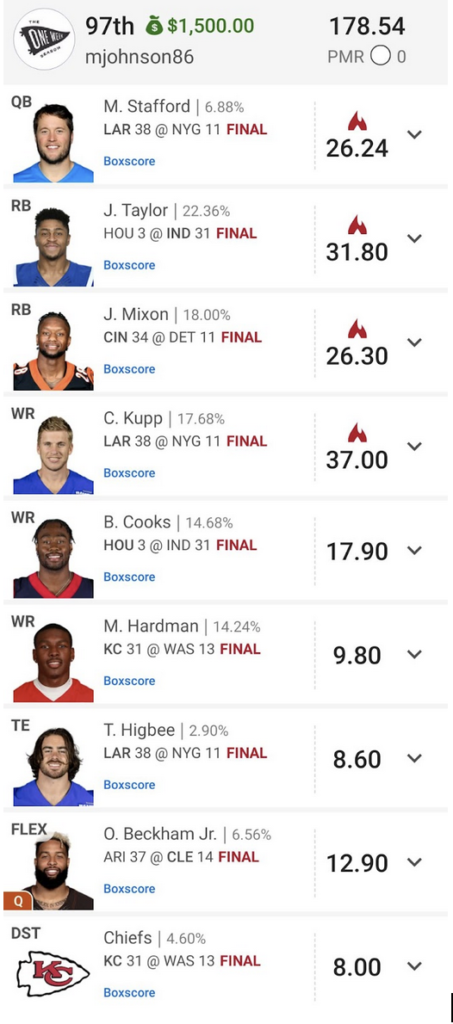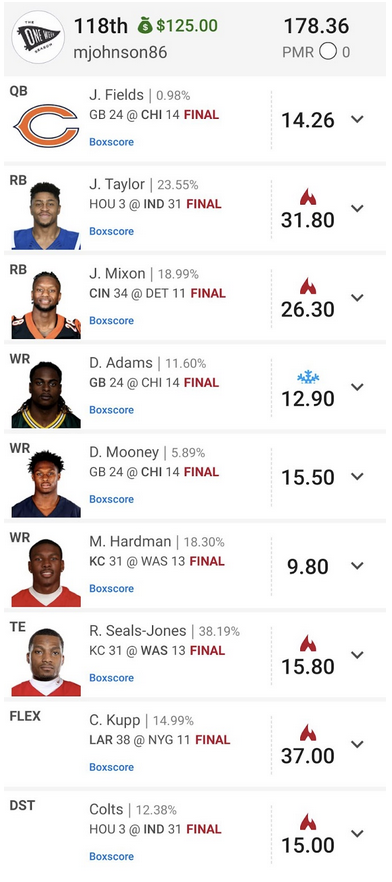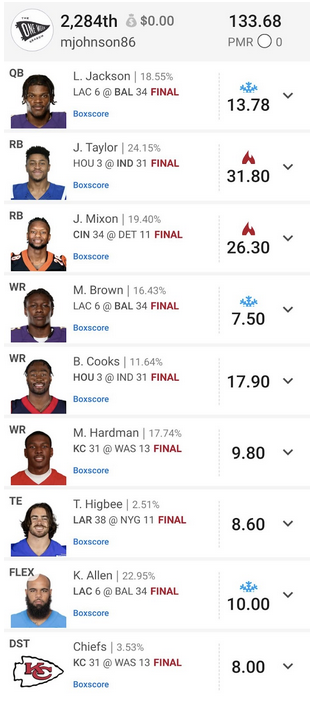Process Points. 7.21.
Lesson of the Week: Road to Success, Path to First
This was a good week for me. My process was sound in my research, contest selection, and roster construction. I had a couple of good sweats with chances into the late games for big scores in the Wildcat on Draftkings and the Deuces Wild tournament on Fanduel. In both lineups, I had Odell Beckham Jr. left in the late games and was in the top 20 in the 2nd half of the afternoon games. Beckham was great leverage off of the Kareem Hunt chalk, and the game script played out perfectly. Losing him for a few series in the middle of the game to a shoulder injury was scary (at least he came back) and certainly didn’t help my chances as he definitely would have seen a few targets during that time and had scoring chances. Also, the runout of the Cowboys game was less than optimal for my teams. The thing to keep in mind, however, is that I had a chance! If that game played out where OBJ had the 35 point game instead of Lamb, I’m at the top of the leaderboards. OBJ has one 35 point game in 10 games for Cleveland over the last two seasons (since Stefanski arrived), and that was last year against Dallas in a high game total game when Chubb left early with an injury. If we say OBJ has a 10% chance at a game like that and then call it 50/50 that the DAL/NE game doesn’t go to overtime (which is where the Lamb lineups really shot ahead), that means I had about a 5% chance at topping the leaderboard — and I’ll take those odds every time! The key lesson here is that you have to have a path to get there.
Over the past few weeks, I’ve been gathering thoughts about the community and DFS industry as a whole. So often, people say, “player X is great in a tournament!” without really exploring what that means or how to implement it. If you play lineups that are full of “good in a tournament” type guys, you’re drawing almost dead. Your core players are likely going to be relatively popular (for the most part) if you are doing things right. The industry is relatively efficient in locating plays and game environments at this point, so if you’re focused primarily on “tournament plays,” you’re going to end up off of many of the plays you will likely need to have a shot. In order to have a chance and be in the mix, you MUST build for ceiling and find great plays first. How I build my player pool is based primarily on the concept of locating highly talented players in good situations — this is the “road to success.” Once you are on the road to success, you can look critically at your lineup and figure out your “path to first.” You don’t need to have a bunch of low-owned players to get to the topmost weeks, just well-thought-out rosters in the context of the slate with a couple of things that give you a chance.
Below is the lineup from the Wildcat that was in the mix. Notice that all of my plays in my core and game stack were fairly popular and weren’t really “sneaky.” My “road to success” was simply being sharp about the good plays and game environments on the slate — building a great player pool. My “paths to first” were:
- Higbee catches a couple of Stafford’s TD’s (he was close before both the Woods and Henderson TD’s)
- Chiefs D has a big day, and along with Hardman, they hurt production for Kelce/Hill/Williams
- Beckham has a ceiling game at the expense of Hunt chalk
All of those are pretty reasonable outcomes to bet on, and all had fine “floors” to them as well, so if they didn’t carry me to first, it wasn’t like they would crater my chances. You can’t have six or seven different plays like that in your lineup, though, or you’ll never even get the chance for one of them to put you over the top.

Lineup Reviews
As outlined in my +EV Primer course (you can find in the Marketplace – either by itself or in the bundle with my player pool course), one of my approaches that keeps me from getting too high or low week-to-week is playing consistent contests and approaching them from a season-long perspective and using that to evaluate my play and ROI. This season, in this article, I will be tracking my progress on a weekly basis as I play the Single Entry (SE), 3-max, and 5-max tournaments in the $20 to $150 price range on DraftKings main slate for all 18 weeks. Rather than sweating or worrying about my ROI every week and “hoping to cash,” – my goal for the season is to maximize profit relative to that long-term investment total. The results of a given week are irrelevant.
Each week I will review the best and worst of my 11 lineups from my “Roster Block” of SE/3-Max/5-Max. Below are this week’s results, and you can find more information about my process/theory for this in my Week 1 Process Points article.
Best Lineup ($200k Three-Point Stance, 5-Max, $33)

The “story” I was telling: Most of my lineups this week were built through the Rams or Chiefs offenses (Mahomes and Stafford), and then I worked to fit my core pieces around them. This lineup was built first through my core of players from my player pool, and then I worked to find a passing game stack that fit around it. Notice that I did include Cooper Kupp in this lineup as well as a Mecole Hardman and Ricky Seals-Jones mini correlation from that Chiefs game. Both of those games were so likely to produce high scores that I wanted to still account for them and have a chance at getting the “right piece” to go in other lineups like this one. RSJ/Hardman were two high-usage players at cheap prices who gave me access to that game while also knocking out the often difficult TE position. Once I had my core in place, I was able to try to find a game stack that I liked using QB/WR/WR with the $18.4k I had left in salary. I did the NFL Edge writeup for the Packers/Bears game, and I noted in there how Fields/Mooney had modest requirements to return value at their price when played together — 250 passing yards, 2 TDs, 1 INT, 30 rushing yards for Fields plus 6/80/1 for Mooney would be 40 total points. Also, Davante Adams is so likely in a given week to have 22+ points, with upside any week to score 35-40 due to his role. Also, the correlation was high as if Davante had a big game, it was likely pushing the Bears offense to be more aggressive than they had been. So if Davante had 25 and the Bears combined for 40, that would have been 65 total points, which is not an unreasonable expectation. Davante stepped out at the 22-yard line on a long play in the 4th quarter that otherwise would have been a TD and put him over the 100-yard bonus threshold — which would have gotten him to around 25 points. The trio instead combined for 42.66 points, and my lineup finished 118th. Had they met the production threshold I laid out, the extra 22.34 points would have moved me into 3rd place for $10k. Only three more points above that would have been first. Also, and this is the critical part, no one else up top had that trio of players (or really any of them individually). If they meet those expectations, it was a clear path to the top for me, which is what we need to have a chance at a big payday.
Worst Lineup ($700k Power Sweep, 3-max, $150):

The “story” I was telling: This was my one Lamar Jackson roster, and I used Marquise Brown as the Ravens pass-catcher to stack as he was likely to be less popular than Mark Andrews while also being underpriced. I liked Keenan Allen as the bring back with Mike Williams likely limited (I was actually glad Williams played as it kept Allen’s ownership from getting out of control, and his presence was likely to draw defensive attention). Notice again that I accounted for the Rams offense with Higbee at the TE position and Hardman/Chiefs D accounting for how that game played out. Cooks/Taylor was one of my favorite correlation plays of the week, and Mixon was at the top of my player pool. The lineup didn’t work out, but I liked the process and how it came together. It told a very clear story for “how the slate played out,” which is something that we need to always keep in mind when building rather than just focusing closely on one game.
Week 6 Results: It was a very solid week with 8 of 11 rosters finishing in the money. My core players did pretty well, and most of my lineups were built around the Rams or Chiefs offenses, which was a good combination.
Week 6 Investment: $792
Week 6 Winnings: $930
Estimated Yearly Investment: $14,000
Yearly Winnings: $2,230
